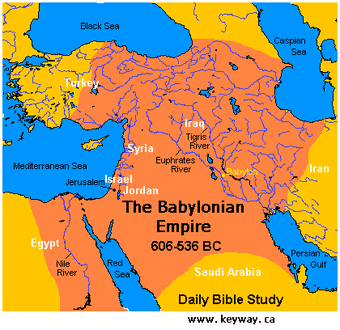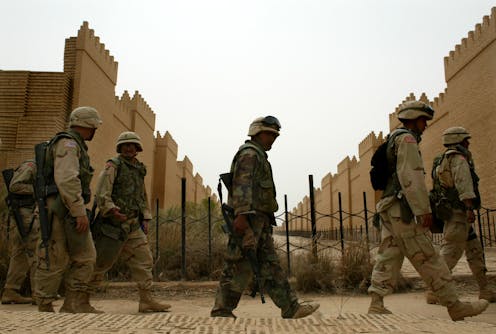- Founding of the City
-In the beginning, Babylon existed as a small village south of Ur along the Euphrates River.
-During the reign of Sargon of Akkad, Babylon was brought into the fold of the Akkadian Empire.
-Sargon established local officials, which allowed for the building of roads, improvement on irrigation, and greater focus on trade.
-Sargon created a standard system for weight and measure, as well as a taxation system allowing for a more unified economy.
-Babylon grows under Akkadian control, though rebellions take place throughout the time of Akkadian rule.
-King Sin-Muballit of the Amorite people took the Babylonian throne in 1812 B.C., abdicating in 1793 B.C. to his son Ammurapi, known by the Akkadians as Hammurabi.
-Through massive military expansion, Hammurabi established the Kingdom of Babylonia, with Babylon as the central ruling city.
Added by Meaghan Anderson
2. General History of the City’s Development
Late Babylonian Empire
Hammurabi’s great accomplishments were not carried on by his successors. The period known as the First Babylonian Empire stretched from circa 1894 B.C. to circa 1595 B.C., after which the empire collapsed. The Empire lost territory, money, prestige and general degradation of its status. The was enhanced by Hittite expansionism resulting in Babylon being sacked by the Hittites circa 1595 B.C. leading to a 500 year rule of the Kassites whose successful rule led to the later establishment of Babylonian culture and customs.
Kassite Dynasty
The Kassite period was the longest dynasty in Babylonian history and the most politically stable. The Kassites were popular among the Babylonians for rescuing the statue of Marduk (the paramount god of the Babylonians) from the Hittites and returning the statue to the city. The Kassites transformed Mesopotamia into a territorial state from a network of allied and sometimes combative states. The period saw Babylon grow as an international power. Under the Kassites Babylon established trade relations with and negotiated borders with the Assyrians. In the mid-16th century B.C. the royal houses of Egypt, Kassites, Elam and Babylon all intermarried. As more foreign merchants began to trade in Babylon the city’s culture started to become more refined and recognizable. Kassites seals, symbols and tools have been found in Egypt, Anatolia, Greece, and southern Armenia showing the widespread trade empire established by a state geographically smaller than her neighbors.
Assyrian Rule
After the mid-15th century B.C. Babylon began to experience a greater threat from Assyria through repeated incursions. Asur-uballit I of Assyria sacked Babylon in the 1360’s after the Kassite King he supported was assassinated. Attacks continued in one form or another until the eventual fall to Assyria in circa 155B.C. Then began a near constant contest in Mesopotamia between the ruling Assyrians and the Elamites. During the reign of Sennacherib, the city was in a state of nearly constant revolt resulting in Sennacherib ordering the city to be razed with the walls, temples, and palaces being destroyed and thrown into the Persian Gulf. Sennacherib’s successors later rebuilt the city and saw the eventual collapse of the Empire due to internal conflicts. Taking advantage of the internal chaos among the Assyrians and inspired by a sense of divine vengeance the Babylonians overthrew the Assyrians under the leadership of a local chieftain and later King of Babylon, Nabopolassar.
Neo-Babylonian Empire
With independence there was a new era of economic growth, architectural advancement, and military conquests. This was led by Nabopolassar’s son and successor, Nebuchadnezzar II who oversaw the construction of the famous Ishtar Gates and the hanging gardens of Babylon, one of the Seven Wonders of the World. He is also associated with the Babylon captivity and destruction of the Second Hebrew Temple. As with Hammurabi, Nebuchadnezzar II’s successors squandered his accomplishments and were quickly destroyed by Persian conquest led by Cyrus II.
Achaemenid Empire
Under Cyrus II and later Darius Babylon became an administrative capital of the Persian Empire and became the epicenter of scholarly astronomy and mathematics. It remained prominent for over two centuries. The religious ceremonies of Marduk were maintained at first but over time the Temples began to deteriorate due to the passage of time and over taxation.
Two rebellions occurred in 521B.C. and 522 B.C. led by Nebuchadnezzar III and Nebuchadnezzar IV but both failed. Babylon remained largely unchanged until the entry of Alexander III of Macedonia in 331 B.C. after the battle of Gaugamela which ushered in the Hellenic period of Babylon.
Added by Joseph Fette

3. Intriguing Features and Events
- Did you know? Babylon’s great King Hammurabi built its first wall, one far surpassing those typically seen in the period, that initially cemented Babylon as a well defended stronghold. That wall pales in comparison, however, to the three walls built by King Nebuchadnezzar II. Not only did the roughly forty-foot walls encircle the city, but they included watch towers and numerous gates, creating incredible defenses for the prosperous city. The walls themselves were said to be wide enough for chariots to race upon, not so easy for outsiders to trespass. Most notable of the gates was the entry, the Ishtar Gate. Within the gate was a private antechamber. Covered in tiles and intricate artwork, the double gates were thirty-eight-feet high, and led to walls over fifty-foot high that made up the Processional Way. This path led to the temple of Marduk and was covered with sculptures and multi-colored tiles. The tile work forms lions, dragons, and bulls, figures that represent Ishtar, Adad, and Marduk. Along the path of the Processional Way, red and yellow stones pave the way, each lying atop an inscribed prayer from King Nebuchadnezzar to the god Marduk. At the front of the gate, an inscription is affixed providing Nebuchadnezzar’s perspective of the gates’ purpose. A massive double wall protected by a ditch walled the city from the Euphrates. To the east, a wall constructed in triplicate extended from the north to south ends of the walled city. Within the main outer walls were more, less impressive walls in an intricate network, with irrigated land lying between the inner and outer wall work. Added by Meaghan Anderson

- Did you know? King Hammurabi made the earliest known written law, etched in cuneiform on a tall stone stele. The codes described the punishment and fees that would be given to a person who broke the law. This is where the term “an eye for an eye” originated!

- Did you know? The tower of Babel narrative in the Bible is thought to have been based on structures like the great ziggurat in Babylon.
- Did you know? The hanging gardens of Babylon were one of the seven wonders of the ancient world! Above Info Added by Melanie Leary

4. Visit Babylon!
Come see Babylon, a city with grand architecture, hanging gardens, and ziggurats! The aqueducts always assure a steady supply of fresh water, and the walls of the city keep out invaders. This is the land where written language and literature began and trading flourished. You will always feel safe here, we were the first to have a written code of laws that punish criminals and ensure the safety of you and your family.
Added by Melanie Leary
5. Later and Modern Babylon
- After the Assyrian control of Mesopotamia weakened in the early seventh century BCE, the Babylonians took control, creating a Neo-Babylonian Empire.
- Rulers such as Nebuchadnezzar II conquered land and deported masses of people, altering the history of the area for thousands of years.

- In the sixth century BCE, Babylon fell to the control of the Persian Empire and its king Cyrus. This marks the end of the Neo-Babylonian Empire.
- Even after the fall of the nation, the strong culture of the last native Mesopotamian dynasty endured.
- Today, the ruins of Babylon are located in modern-day Iraq about 60 miles southwest of Baghdad.

- Over the years the ruins have been damaged by various wars and conflicts in the area. At one point American soldiers set up base near the ruins.
- Efforts for conservation changed the way the site looks as bricks were placed on top of original foundations in order to reconstruct what they would have once looked like.

- In addition to the damage caused by war and conflict, early archaeologists also caused damage to the site. The prized Ishtar Gate was taken from the site in the early 20th century, and is currently exhibited in the Pergamon Museum in Germany. A reconstruction is all that is left of the gate on site. Added by Melanie Leary
BIBLIOGRAPHY
Akigka, . “Phoenician Trade Network.” Ancient History Encyclopedia. Last modified April 26, 2012. https://www.ancient.eu/image/116/.
Cartwright, Mark. “The Phoenicians – Master Mariners.” Ancient History Encyclopedia. Ancient History Encyclopedia, April 7, 2020. https://www.ancient.eu/article/897/the-phoenicians—master-mariners/.
Delnero, P. (2008). Babylon: Myth and Truth, an Exhibit at the Pergamon Museum. Near Eastern Archaeology,71(3), 181-184. Retrieved April 8, 2020, from http://www.jstor.org/stable/20361372
Mark, J. J. (2011, April 28). Babylon. Retrieved from https://www.ancient.eu/babylon/
Mark, J. J. (2009, September 2). Sargon of Akkad. Retrieved from https://www.ancient.eu/Sargon_of_Akkad/
Mieroop, M. Van De. (2007). A History of the ancient Near East: ca. 3000-323 B.C. Malden, MA: Blackwell Pub.